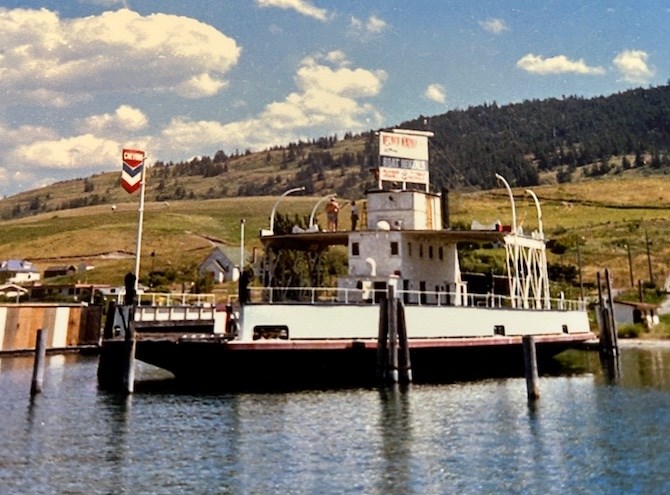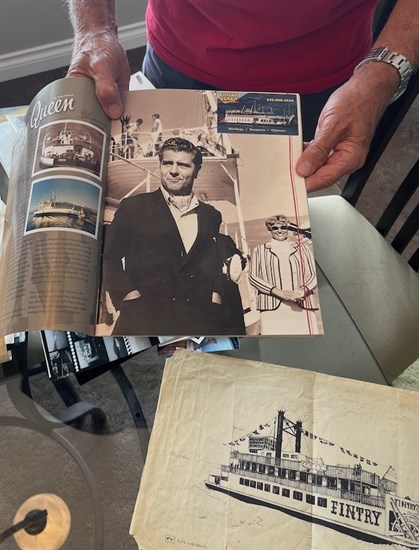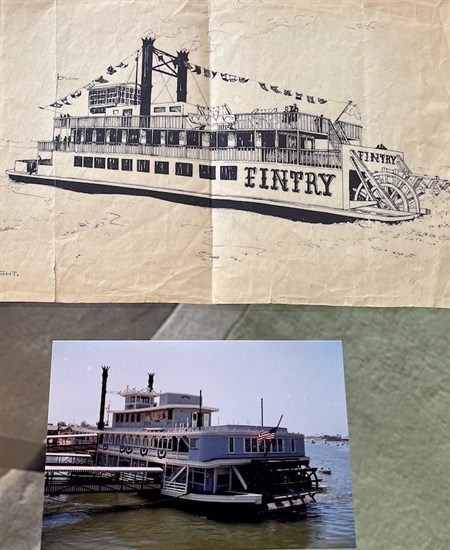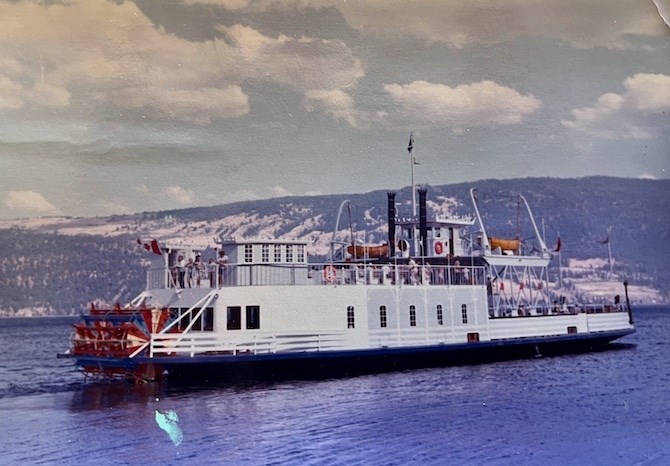
This is the MV Legume docked at Okanagan Falls before it was towed across Okanagan Lake and turned into the Fintry Queen.
Image Credit: Submitted/Graham Bailey
June 18, 2023 - 6:00 AM
The story of Fintry Provincial Park is rife with stories of financial collapse.
That includes the failed attempts of Arthur Bailey to restore and develop the land, with the aid of a converted ferry boat dubbed the Fintry Queen, only to lose it all decades later and see it turned into a park.
“He had a dream to try to turn Fintry into some sort of development where there would be camping and horses and golf and all sorts of recreational activity on it,” his son, Graham, told iNFOnews.ca. “We lost the land. We lost the boat. All due to taxation.”
It was the province that ended up getting the land and turning it into Fintry Provincial Park by 1996.
The history of Fintry dates back to about 1909 when James Dun-Waters bought the delta at Shorts Creek on the west side of Okanagan Lake and named it Fintry, after a place in Scotland.
He developed an impressive farm and orchard operation, complete with manor house and packing plant.
READ MORE: iN PHOTOS: The founder of Fintry was no remittance man, he just looked like one at times
As he had no heirs, he gifted the land to the Fairfield Farm School in 1939. The school brought children out from England to teach them farming but ran out of funds and closed in 1948.
It was bought by an American land developer who ended up defaulting on his loans.
Arthur Bailey, a Vancouver developer, started visiting Fintry in 1959 and, in 1962, acquired the land.
“There was a bit of a scam going on with selling properties and not giving people their titles so, when we bought Fintry, we created the first Trust Lot Subdivision in BC,” Graham said.
The previous owner sold lots in Fintry, mostly to Prairie residents, for $10 down and $10 a month until $1,000 was paid for each lot, but he absconded with the money.
Part of the requirement for Bailey to buy the land was for him to provide a lot to everyone who could prove they paid even $10, which was known as a Trust Lot. And he had to service the lots with a road.

This is a photo of Arthur Bailey from a Suncruiser magazine article.
Image Credit: Submitted/Graham Bailey
In exchange, he got about 2,000 acres both down on the delta along the lake as well as hay fields and buildings in the upper area of the property.
Hundreds of lots were created above Westside Road. Many owners never saw their lots and just sold them on. Others came out expecting waterfront to find their land on a hillside. While many houses have been built on the land, there are still quite a few vacant lots, Graham said.
The Baileys set out to restore what had become a derelict property.
An estimated 1.5 million bats were taken out of the manor house attic and destroyed – although a bat house was built. Hundreds of pack rats were taken out of the house.
“He (Arthur) wanted to bring people to the property but it was a one lane dirt road from Kelowna and it’s a two lane dirt road from the Vernon side and he thought, the best way to get people to the property to expose them to it was by ship,” Graham said.
The 40-metre long MV Lequime had been built as a ferry in 1947 and plied the waters between Kelowna and Westbank until 1958 when the first floating bridge was built.
By 1965, when Arthur Bailey bought it, the Lequime had been derelict for 15 years, Graham said. It was moored at Okanagan Landing where it was being used for things like renting motorbikes and boats.
They towed it across the lake to Fintry using Arthur’s 30-foot Chris-Craft motorboat and started dismantling it.
“Every one of the decks had to be stripped.” Graham said. “After having car service on it, there was a lot of tar and buildup on the decks so we had to heat them up and scrape all the tar off.
“We had to clean the bilges. That was my job. I had to go down there with a bucket under the engine area and all through the lowest part of the ship’s hull and scrape all the garbage that had been left down there. A lot of muck came out of there, by the barrel.”
Arthur traveled to San Diego where he measured up the Reuben E. Lee, which was actually a barge with a paddlewheel built onto it in the 1960s. It served as a floating restaurant until 2004. In 2012 it was moved and subsequently sunk.

In the bottom photo is the Reuben E. Lee in San Diego. It was the model for the Fintry Queen.
Image Credit: Submitted/Graham Bailey
“The whole idea was to try to build something that was themed for Fintry,” Graham said. “In keeping with the history, when you did everything on the lake by sternwheeler in the old days. There were no roads. We were trying to restore Fintry at that time and we thought we would just keep the theme going.”
Fintry had been a “whistlestop” for the old steam powered sternwheelers that would stop for things like picking up fruit, which is why the Fintry had a replica paddlewheel installed.
The stripped down boat was towed to Westside Docks for welding and was rebuilt in three phases from the back to the front.
By the winter of 1968 it was docked in Kelowna as a 110-seat, high-end restaurant.
While some sources seem to credit the rebuild to Cap Capozzi, that was not the case. Capozzi, who owned the Capri Hotel and Calona Wines, was a family friend who was invited to officially launch the Fintry Queen. He insisted on using one of his own Calona Wines bottle rather than champagne at the opening ceremony.

This is a newspaper picture of Herb "Cap" Capozzi and Helen Graham at the Fintry Queen launch. Helen was Graham Bailey's grandmother and the financier of the project.
Image Credit: Submitted/Graham Bailey
“The whole idea was to take people out there (to Fintry) to picnic,” Graham said. “We wanted to introduce them to the fact you could camp out there right on the lakeshore. We had a dude ranch. We had shops. We had a beer parlour. We had a marina where you could run boats. We had a restaurant.”
The Fintry Queen was an integral part of Arthur’s dream to restore the site to its original glory.
“When you couldn’t take tourists out to Fintry in the summer – it was a big capital outlay for the ship – you could take cruises around the Kelowna lakeshore and through the bridge down south,” Graham said. “We would go to Summerland and Westbank and pick up charters whenever we could.
“A lot of Christmas parties were held on it. For about five years running, Kelowna Secondary School ran their grad party – an overnight, all night cruise on the Fintry Queen. We would go to Fintry and make a pancake breakfast for all the students the next morning.”
By 1969, Graham said, the Fintry Queen was a viable operation, grossing more than $100,000 that year.
READ MORE: iN VIDEO: See Fintry Estate before new housing came in 1965
The whole thing started falling apart a few years later, after Dave Barrett led the NDP to power in 1972 and created the Agricultural Land Reserve the next year.
“They brought in the ALR but they taxed your lakeshore virtually as if you were in downtown Kelowna,” Graham said. “We went from something like $10,000 a year in land taxes at Fintry to over $100,000. We then had to scramble and create activities so we could fund these tax payments.”
That included moving away from being hands-on operators of the Fintry Queen.

This is the completed Fintry Queen.
Image Credit: Submitted/Graham Bailey
“The minute we took our own personal management away from it and hired a manger, we were having a lot of money going wide of the till,” Graham said. “We weren’t making near the money we expected. We had to focus on saving the land.”
A short time later they had to give up the ship.
“We lost the Fintry Queen for around $60,000 to $70,000 to the Bank of Montreal and we were into it for almost $700,000,” Graham said.
The bank found another buyer.
The Baileys were able to hang on to the land, barely, until the late 1980s, partly by selling of parts of it off.
“My father did have development dreams for Fintry,” Graham said. “He had a golf course lined up but a golf course doesn’t pay the bills."
They had kept Fintry as historically intact as possible which, Graham said, actually backfired on them.
“That’s what made it interesting for the government,” he said. “It hadn’t been all chopped up and modified.”
By the end, they were struggling to pay the “money lenders” at a time when the government was interested in buying the land for a park.
“We had placed four or five offers in front of the money lender,” Graham said. “He wouldn’t take them. He just kept listening to the government’s offers, ongoing offers.”
Eventually they were forced out and the province joined with the Central Okanagan Regional District to buy the land for the park.
The Fintry Queen continued to function as a cruise ship and floating restaurant until 2000. At that time, Andy Schwab was a co-owner and couldn’t get the boat recertified by Transport Canada because they insisted it be lifted out of the water for its hull inspection.
That demand came despite the fact that Graham and his brother had done similar annual inspections as scuba divers back in their day.
Schwab says it could cost almost $100,000 to get it certified and fixed up again but he has not been able to get financial backers to get that done.
Even so, he plans to start canvassing tourism associations and local governments for support this year.
READ MORE: Poor, old Fintry Queen still trying to make waves
Graham Bailey is skeptical.
“I’d say a couple hundred thousand would get it operational and approved,” he said. “It’s not been maintained. He’s going to have to spend some money very very soon on that boat or he’s going to have a problem.”
To contact a reporter for this story, email Rob Munro or call 250-808-0143 or email the editor. You can also submit photos, videos or news tips to the newsroom and be entered to win a monthly prize draw.
We welcome your comments and opinions on our stories but play nice. We won't censor or delete comments unless they contain off-topic statements or links, unnecessary vulgarity, false facts, spam or obviously fake profiles. If you have any concerns about what you see in comments, email the editor in the link above.
News from © iNFOnews, 2023